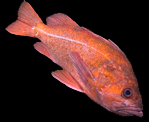
Giant plumed anemone, Metridium farcimen
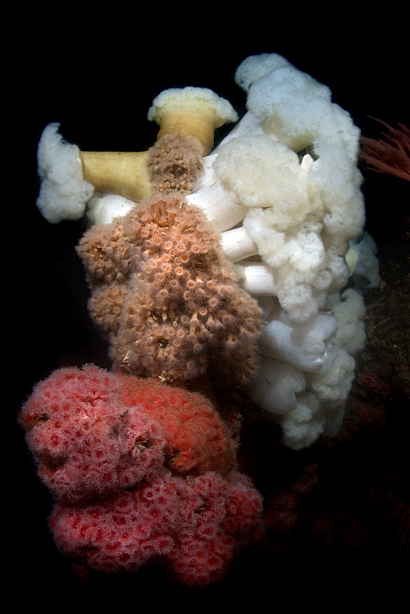
A column of anemones. From top to bottom: giant plumed anemones (Metridium
farcimen), yellow zoanthids (Epizoanthus scotinus), and club-tipped
anemones (Corynactus californica). This is an example of how strobe
lighting can be used to manipulate how the human eye and brain perceive a scene.
In this case the strobes were set to make the Metridiums appear higher
off the bottom than the Corynactus. This isn't actually the case. The
subject's true orientation actually makes it look rather unphotogenic. I was a
little slow to realize how pretty this column is, and, oddly enough, this shot
was taken more out of frustration than anything else. The sole purpose for this
dive was to take pictures of a subject about three feet away. These pictures
didn't turn out nearly as well as I had hoped and I switched to taking shots of
this anemone column to console myself.
"Deep Shale", Monterey Bay, California
April 16, 2005
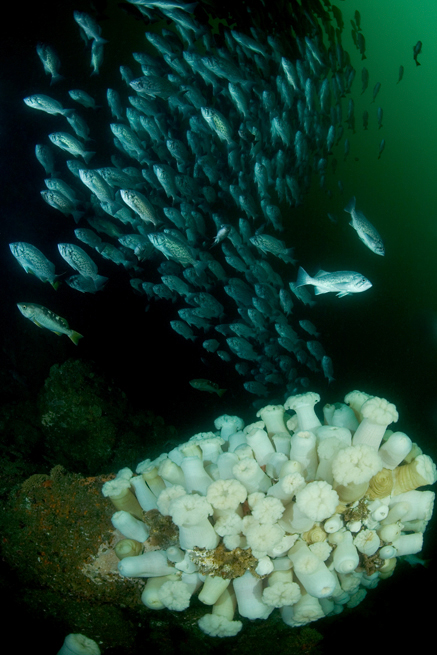
Blue rockfish (Sebastes mystinus) are Monterey's most interesting
schooling fish, particularly when they pack into large, dense aggregations like
this. The corner to corner angle of view in this shot is a full 180 degrees, but
even so, it seems a little too narrow. Super wide angle lenses are, of course,
great for the underwater photographer since they allow pictures of large reef
scenes unobscured by particulate matter in the water. At some point, however,
things start getting difficult. With my current lens, I have to be careful to
keep hands and elbows out of the shot. With a lens that was wider still, I
suspect I might have to -- as a friend of mine has suggested -- tape back my
ears or something. While big schools like this can still be found in more remote
places, it's quite unusual to see something like this in areas that are under
heavy fishing pressure. Actually, in many hundreds of dives in Monterey bay,
this is the only such school I've seen. That this school was considerate enough
to swim next to a big bunch of Metrdidium farcimen was an added bonus.
I'm a extra fond of this picture because it's the only reasonably good shot I've
taken while swimming backwards. "Backwards?" you say. Yes, as it turns out, one
of the charms of the 60's era Scubapro fins I use is that they are particularly
well-suited to swimming backwards. It's something that takes a bit of practice,
but is not so unreasonable as it sounds. And, no, there are no hands involved in
this backward swimming. All this being said, it's most often used to get oneself
out of a tight spot when current or surge is about to smash one into the end of
a narrow hole or crack in the reef. In such situations I'm usually more worried
about scratching my camera port than I am about getting a shot. In this case
however, I was able to correct for an initial overshoot in approaching the
subject. Hopefully this means I've managed to add one more item to my bag of
photographic tricks.
"Ballbuster", Monterey Bay, California
October 15, 2006
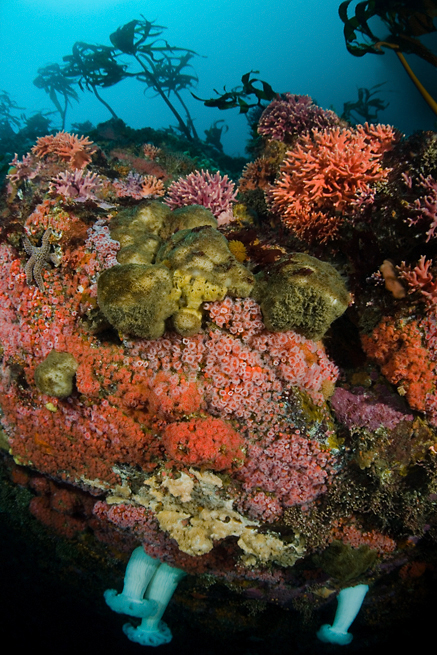
Up or down? Having been quite disappointed by Canon's 15mm fisheye lens, I
picked up Sigma's version. So far, it looks like the new toy adapts to
underwater life much better than does the Canon. I suspect there will be a used
Canon fisheye going up for sale on eBay soon. This shot contains nothing more
than the usual Carmel Bay subjects: California hydrocoral (Stylaster
californicus), Corynactis californica, and Metridium farcimen.
However, I like it because of the lighting -- actually, the lack of lighting in
the bottom of the shot and that the Metridiums don't seem to need any
illumination to show up just as saliently as they always do. It almost seems
like the bottom of the shot is some sinister complement to the heavenly blue
water at the top. I suspect this picture wouldn't have been nearly as successful
if taken on a day when Carmel Bay's water was its more usual green.
"Outer Pinnacles", Carmel Bay, California
January 28, 2007
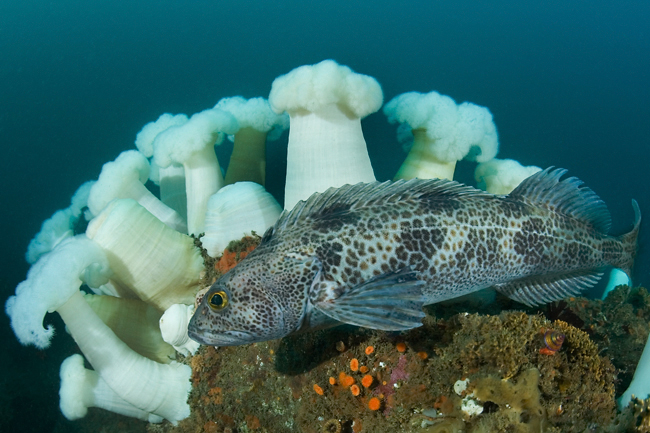
Large lingcod (Ophiodon elongatus) are seldom seen in areas under heavy
fishing pressure. At Hopkins Deep Reef, one encounters mostly runty ones like
this. Though, the fisherman's heartbreak may be the photographers joy: small
lingcod are nicely proportioned against a backdrop of Metridium
farcimen.
"Hopkins Deep Reef", Monterey Bay, California
January 21, 2007
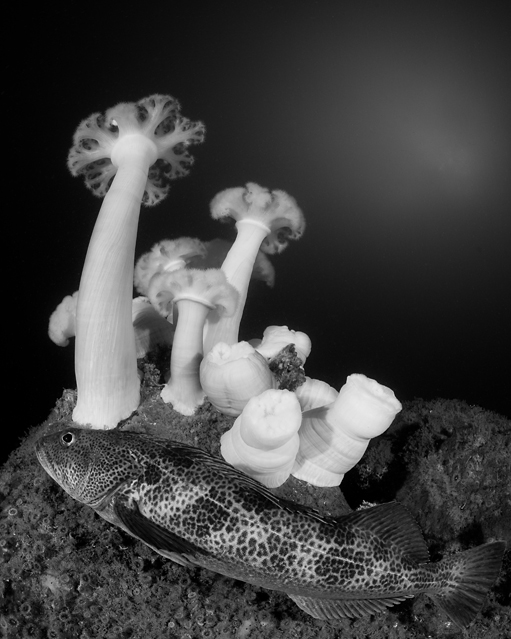
I spent a little time fussing with various pictures I'd taken, converting them
to black and white. I quickly discovered that while this seemed like a good
idea, the results usually look rather wretched. So, I decided that maybe I
should be thinking about black and white while still in the water. This is the
first shot I took with black and white conversion in mind. Metridium
farcimen and lingcod (Ophiodon elongatus) are both high contrast
elements. Of course, I would have liked a wonderful sunburst in the background,
but conditions didn't provide for this. Instead, I got a sun-blob.
"Hopkins Deep Reef", Monterey Bay, California
February 11, 2007
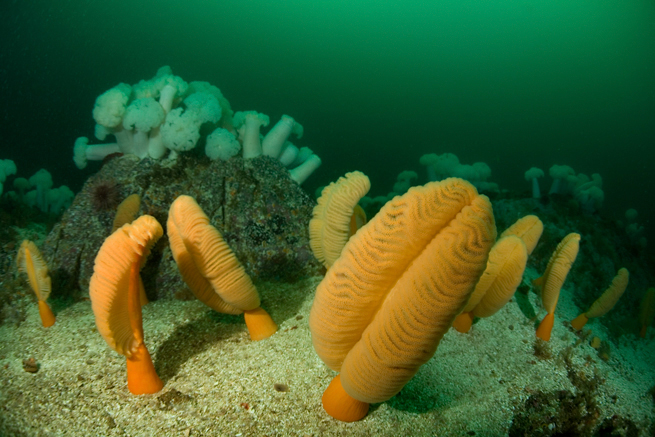
Fleshy sea pens (Ptilosarcus undulatus) and Metridium farcimen.
"Hussar Point", Browning Pass, British Columbia
September 6, 2006
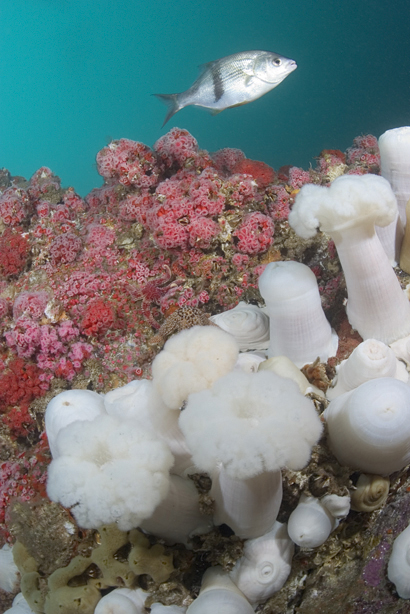
Pile perch (Damalichthys vacca), club tipped anemones (Corynactis
californica) and giant plumed anemones (Metridium farcimen). Days in
which the water is clear enought to take pictures with minimal backscatter and
this large a depth of field are not common inside Monterey Bay.
"Ballbuster", Monterey Bay, California
December 17, 2005
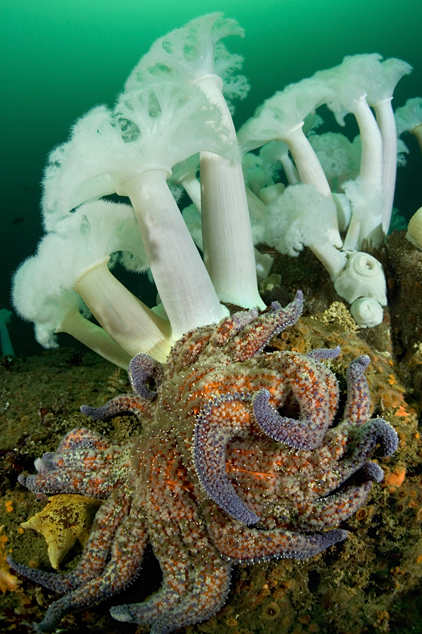
Visitors to Hopkins Deep Reef will immediately notice both the giant plumed
anemones (Metridium farcimen) and the sunflower stars (Pycnopodia
helianthoides). Sun stars most often assume a rather mundane posture. This
one, however, appears to have taken up some form of yoga. Sun stars, are, in
fact quite pliable. Hold one in your hand (above water, that is), and, apart
from the fact it's pretty much impossible not to rip off a number of the
animal's tube feet, you'll notice that they drape over your hand like a wet dish
towel.
"Hopkins Deep Reef", Monterey Bay, California
August 13, 2006
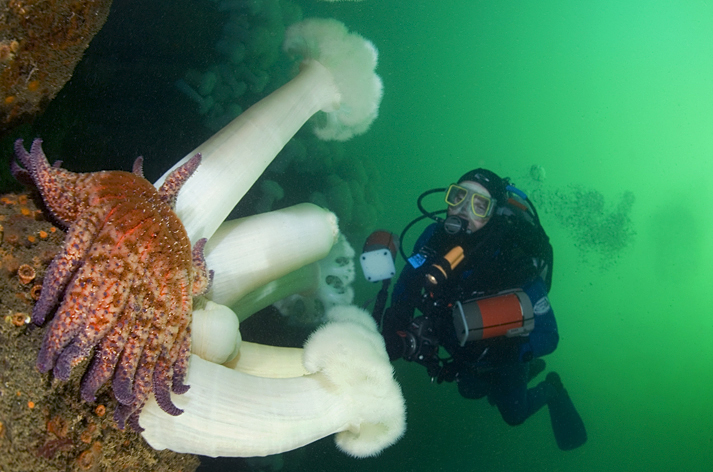
A sunflower star (Pycnopodia helianthoides) on the move near some
Metridium farcimen. Chuck Tribolet was kind enough to pose, completing
the scene.
"Hopkins Deep Reef", Monterey Bay, California
May 14, 2006
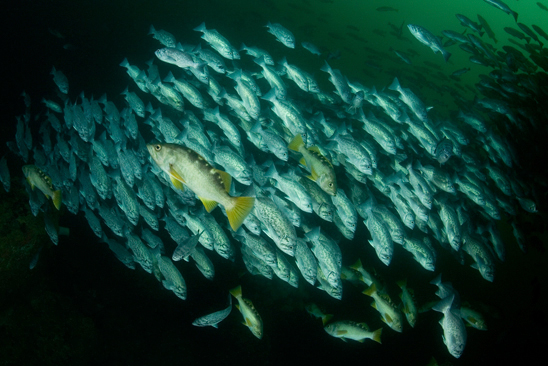
This olive rockfish (Sebastes serranoides) is bucking the trend set by
his blue rockfish (Sebastes mystinus) peers. Likely the camera got a
little too close for comfort.
"Ballbuster", Monterey Bay, California
October 15, 2006
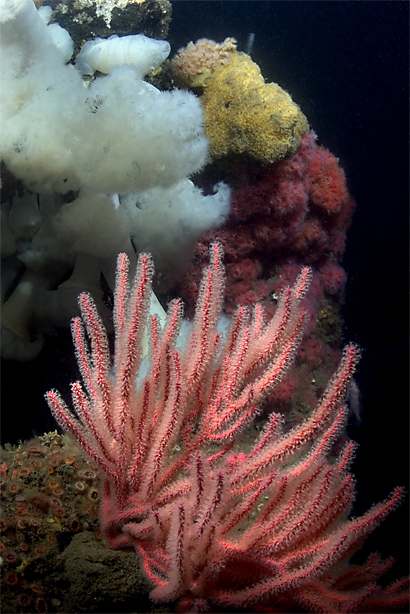
Red gorgonians (Lophogorgia chilensis) contrast nicely with white giant
plumed anemones (Metridium farcimen).
"Deep Shale", Monterey Bay, California
April 16, 2005














